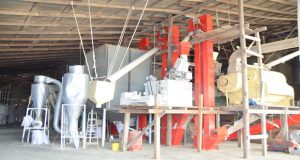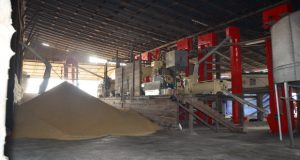President commissions pioneer gasification plant in Essequibo – deems initiative a welcome development
By Rebecca Ganesh, March 23, 2015, Source

PRESIDENT Donald Ramotar on Saturday officiated at the launch of what is likely to be Guyana’s first ever gasification plant, and a first for the County of Essequibo as well. The facility at reference is located at the Ramlakhan Rice Mill at Ex-Mouth, on the Essequibo Coast, where the Head of State spent some quality time having a first-hand look at how the gasification process works, using rice husk to produce energy to power the mill.
There, President Ramotar, in brief remarks, made it known that the Government is sparing no effort to improve production and boost the rice industry under the umbrella of the Low-Carbon Development Strategy. “We have taken this approach not only from a cost perspective and the instability of fossil fuel prices, but also as a programme to reduce carbon emission,” he told invitees to the commissioning.
The Head of State also stressed that the Government is always looking for ways to diversify the rice industry, and that with reducing the cost of the production of rice through this new plant “we can add more value to our product.”
The President lauded the Ramlakhan Rice Mill for being one of the first mills to come on board with this programme. He noted that the mill is presently using 70% of the energy from the gasification plant and 30% of diesel.
“Ramlakhan and Sons Rice Mill at Ex-mouth, Essequibo Coast was the first to take the initiative and purchase a gasification plant,” President Ramotar proudly noted. The plant arrived late last year and the installation and successful testing have recently been completed.
HOW PROCESS WORKS
Guyana Chronicle spoke with Dr Garnarsian from the Office of Climate Change that is based at the Rice Mill. He explained how the gasification plant works, noting that the rice mill produces about three tonnes of rice per hour.
The rice husk will fuel the gasifier and the gases emitted are cleaned of solid particles, tar/carbon and water/moisture, and directed into the combustion chambers of a 250 kw powergen set, replacing 70 % of the diesel required to run the genset. “We need 600kg of husks to power the mill to full capacity,” he explained, adding that only recently, on Phagwah day, “we did a full capacity test again to make sure that during harvest we have no hiccups.”
He explained that the rice mill, prior to the acquisition of the new plant, utilised 100% diesel to power the mill. “But now we use 70% of the power from the gasification plant, and 30% diesel,” Dr. Garnarsian said. The implementation of the plant, he stressed, will save the mill owners revenue on production cost making their produce more marketable.
Some rice mills are using wood as fuel to meet thermal energy demand, but minimal use is made of rice husk. Residents have made numerous complaints about the health risks associated with rice husk, because if the rice husk is not used, it becomes an environmental problem of enormous proportions.
MOU
The Guyana Government and The Energy and Resources Institute (TERI) of India signed a Memorandum of Understanding (MoU) on May 25, 2011, to provide support as Guyana implements its climate initiatives and Low Carbon Development Strategy (LCDS).
TERI identified that the energy cost component in direct expenses is over 35% in rice mills. The cost of energy accounts close to US $15.50 per metric tonne of paddy processed. It is mainly due to the use of diesel for power generation.
Energy management and conservation is an important tool to help the rice industry to meet its critical objectives for short-term and long-term goals. Enhanced energy efficient technologies for design and retrofits of rice mills have been identified to improve energy efficiency, lower the industry’s dependence on fossil fuel, reduce the environmental impact, and reduce carbon emission and lower cost of production. --- By Rebecca Ganesh


